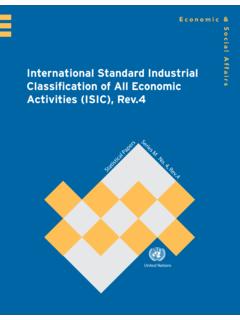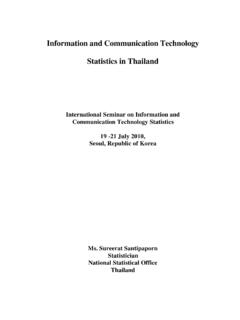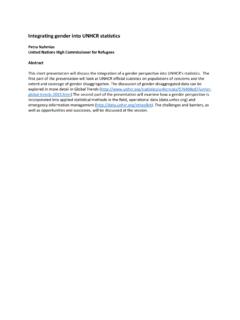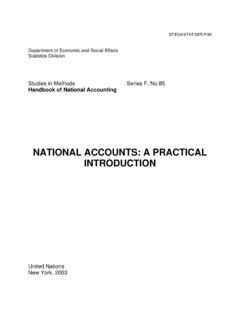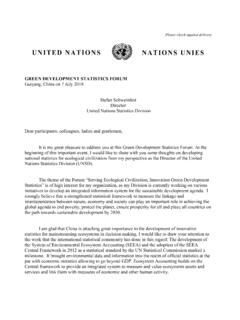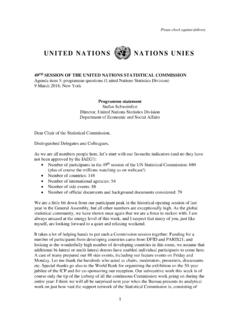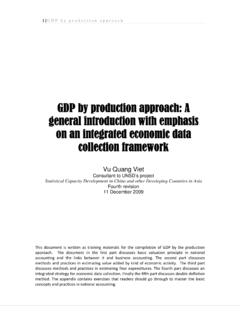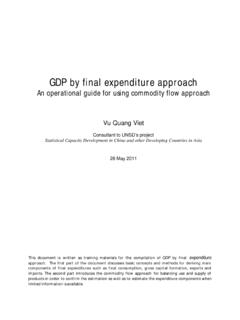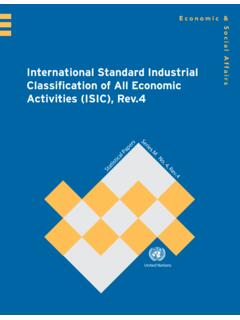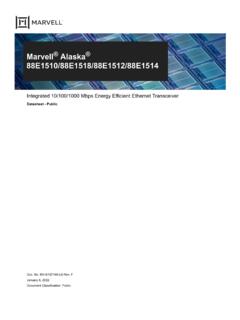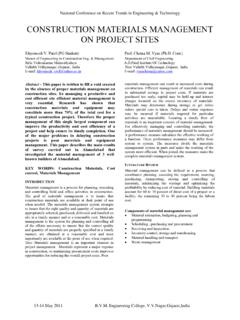Transcription of International Standard Industrial Classification of All ...
1 International Standard IndustrialClassification of All Economic Activities(ISIC)Revision NATIONSE conomic &Social Affairs ST/ESA/ DEPARTMENT OF ECONOMIC AND SOCIAL AFFAIRS STATISTICS DIVISION STATISTICAL PAPERS SERIES M NO. 4, International Standard Industrial Classification of All Economic Activities (ISIC) Revision United Nations, New York, 2002 NOTE Symbols of United Nations documents are composed of capital letters combined with figures. Mention of such a symbol indicates a reference to a United Nations document. ST/ESA/ UNITED NATIONS PUBLICATION Sales No.
2 ISBN 92-1-161456-2 Inquiries should be directed to: SALES SECTION PUBLISHING DIVISION UNITED NATIONS NEW YORK, NY 10017 Copyright United Nations 2002 All rights reserved 3 Preface The International Standard Industrial Classification of all Economic Activities (ISIC) is the International reference Classification of productive economic activities. Its main purpose is to provide a set of activity categories that can be utilized for the production of statistics according to such activities. Since the adoption of the original version of ISIC in 1948, the majority of countries around the world have used ISIC or developed national classifications derived from ISIC.
3 ISIC has therefore been providing guidance for countries in developing national activity classifications and has become an important tool for comparing statistical data on economic activities at the International level. The final draft of revision of ISIC was considered and welcomed by the Statistical Commission at its thirty-third session in March It now replaces the third revision of the Classification ,2 which has been in use since 1989. 1 See Official Records of the Economic and Social Council, 2002, Supplement (E/2002/24), para.
4 54 (a). 2 Statistical Papers, , (United Nations publication, Sales No. ). 4 Summary of contents Paragraphs Page Part one. Introduction to 1 73 7 Part two. Broad and detailed structure .. 41 Part three. Detailed structure and explanatory notes .. 55 Part four. Alternate aggregations and special groupings .. 174 199 179 Part five. Correspondence 200 207 187 5 Table of contents Paragraphs Page Part one. Introduction to ISIC .. 1 173 7 I. Historical background and 1 9 8 A. Historical 1 5 8 B.
5 The 2002 update to Revision 3 .. 6 9 9 II. The underlying principles of the 10 107 10 A. Purpose and nature of the 10 19 10 1. General considerations .. 10 14 10 2. Differences from other types of classifications .. 15 19 11 B. Principal, secondary and ancillary 20 31 12 C. Principles used in constructing the 32 39 14 1. Criteria in respect of divisions and groups .. 32 35 14 2. Criteria in respect of the classes .. 36 39 14 D. Statistical units .. 40 77 15 1.
6 General remarks .. 40 51 15 2. Statistical units in the System of National Accounts .. 52 62 17 3. Delineating statistical units .. 63 75 18 4. National differences and application of statistical units .. 76 77 20 E. Classification of statistical units .. 78 107 21 1. General guidelines .. 78 81 21 2. Treatment of mixed activities .. 82 86 21 Example: Identifying the principal activity of a reporting unit using the top-down 22 3. E-commerce .. 87 89 24 4.
7 Repair and maintenance .. 90 24 5. Activities on a fee or contract basis .. 91 25 6. Government activities .. 92 25 7. Classification of enterprises .. 93 96 25 8. Classification of households .. 97 98 26 F. Structure and coding system of the Classification .. 99 107 26 III. Application of the 108 132 28 A. General remarks .. 108 114 28 B. Use of ISIC in establishing related national classifications .. 115 116 29 C. Aggregation and disaggregation of ISIC.
8 117 122 29 D. Capturing information about the activity of units and coding it according to ISIC .. 123 124 30 E. Use of different levels of the Classification for the presentation of 125 126 31 F. Compilation of homogeneity ratios .. 127 132 31 IV. Relationship with other classifications .. 133 155 32 A. General remarks .. 133 32 B. Relationship with product classifications: CPC, HS and SITC, .. 134 137 32 C. Relationship with other classifications of goods and services (BEC, EBOPS) 138 139 33 D.
9 Other derived and related activity classifications (NACE, ANZSIC, NAEMA, NAICS, ICFA) .. 140 148 33 1. Derived classifications .. 142 146 34 2. Related 147 148 34 6 Paragraphs Page E. Relationship of other International classifications with ISIC .. 149 155 35 V. Other topics .. 156 173 36 A. Changes in ISIC, , as compared with ISIC, 156 162 36 B. Indexes to the Classification .. 163 164 37 C. Correspondence tables .. 165 168 37 D.
10 Special-purpose groupings of ISIC/alternate 169 170 38 E. Support for ISIC users .. 171 173 38 Part two. Broad and detailed structure .. 41 I. Broad structure .. 42 II. Detailed 43 Part three. Detailed structure and explanatory 55 A Agriculture, hunting and 56 B Fishing .. 61 C Mining and quarrying .. 62 D 67 E Electricity, gas and water supply .. 124 F 125 G Wholesale and retail trade; repair of motor vehicles, motorcycles and personal and household 129 H Hotels and restaurants.
